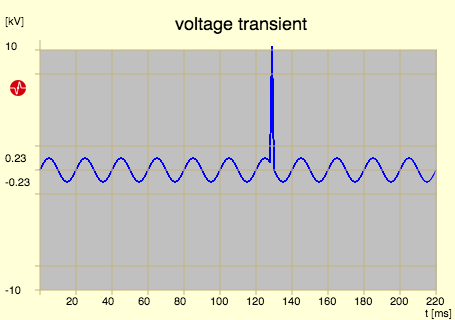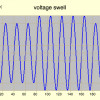This post deals only with the aspects related to energy metering.
Transient voltages are short time surges in the a.c. power supply. They typically last a few milliseconds and the voltage can reach several thousand volt. A transient is by definition shorter than half cycle.

Causes for transients
There are two major groups of transient voltages.
Power system switching transients
Power system switching transients can be separated into transients associated with:
- major power system switching disturbances, like capacitor bank switching
- minor local switching activity or load changes in the power distribution system
- resonating thyristors circuits
- short circuits
- arcing faults to the grounding system
Lightning transients
- direct lightning stroke
- induction due to an indirect lightning stroke
- nearby lightning-to-earth discharge
Energy meters can not detect a voltage transient. The event is too short. Most power quality analysers are designed to capture surges in voltage.
The energy meters are protected to surge effects according to IEC61000-4-5.
For certain regions additional external arresters can be added during meter installation.
Editor's note: This article was originally published in January 2020 and has been updated for comprehensiveness.







Hi Laoren, is Short Duration Peak (SDP) same with transient voltage? We are required to include SDP in our reporting. However, we cannot find a standard to tell us the criteria like magnitude and duration.
Thank you for your question. A transient voltage has a duration of less than half cycle. This is too short to capture with conventional metering equipment. I suppose, your client wants to capture short duration peaks in current. This is a figure coming from circuit breaker- or switch gear testing (IEEE C37.04-1999). The duration is > 0.3 s and the current rating is 2.5 times of the rated short-time withstand current. Values higher than that will trip the breaker.
You can report the event duration and the current. I would report everything starting with 2 times of the short-time withstand current. But as far as I know, there are no regulations except the above given data.
just today i read your blog post. it is so useful information. thank you so much LaoRen
is it possible to share the Medium Voltage Safety
Thank You LaoRen
Thank you for taking a look and for the kind comment.
Working with medium voltage needs a special education and regular training. In many countries even a licence is required.
I'll collect some material from our medium voltage protection division for theoretical explanation.
In any case, read and follow your power company instructions, briefings and regular trainings.
Stay safe!
(Your email address is removed from the visible comment for privacy protection.)
Dear LaoRren, I have started reading some of your blog entries, and I find them very helpful and well written. On the subject of transient voltages, there are also surges that are frequently applied to meters in EMC testing, e.g. 6kV at 50µs. In the case of a poly-phase meter, is the surge voltage typically applied to all three phases, or just one at a time? It is very difficult to find an answer on the web. Knowing the test method helps understanding how transformers and other components on the grid side of the meter have to be isolated.
Thanks!
Wolf, thanks for your comment. The surge immunity test is described in IEC 61000-4-5. A polyphase meter is connected with all phases, but the surge applies only to one phase at time. Take a look at the wiring schematics in figure 10 of the IEC.